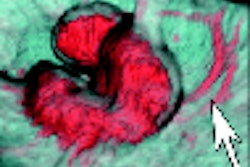NEW ORLEANS - Ruling out pulmonary embolism on a CT pulmonary angiogram may be just what the doctor ordered, but the radiologist will know better: Nearly one-third of those PE-negative scans will reveal an alternative diagnosis for the patient's symptoms, according to a new study.
Researchers from the Mallinckrodt Institute of Radiology in St. Louis, MO, retrospectively catalogued the findings from 505 consecutive patients who underwent CTPA on either a four-slice or 16-slice scanner over a three-month period at their institution.
Mallinckrodt residents Dr. Karun Sharma and Dr. Krishna Thirumala presented the group's findings in a pair of presentations Tuesday at the annual meeting of the American Roentgen Ray Society (ARRS).
Just 16% of the patients scanned were found to have pulmonary emboli, Sharma reported. The yield was nearly the same for inpatient referrals and patients referred from the emergency department. Eighty percent of those PE-positive patients also had additional non-PE findings on their scans.
Among those who were PE-negative, 31% had an evident alternative diagnosis that was subsequently confirmed by correlative laboratory data or clinical outcomes. Another 10% had possible alternative diagnoses that could not be confirmed.
The most common alternative diagnoses included pneumonia and pulmonary edema, seen in 10% and 9% of patients, respectively. Less common alternative diagnoses included atelectasis and pleural effusion, chest wall lesions, and chronic obstructive pulmonary disease (COPD), Sharma said.
Among the rare alternative diagnoses, occurring in less than 2% of the patients, were lung cancers and esophagitis.
Although none of the scans were performed with cardiac gating, some 80% of the PE-negative patients exhibited cardiovascular findings of some kind or other, Thirumala reported.
As might be expected in a patient population with a mean age of 56, the dominant findings were atherosclerosis, coronary calcification, and pleural effusion.
But some 5% of the PE-negative scans showed subsequently confirmed evidence of cardiovascular conditions that could explain the patients' presenting chest pain or dyspnea. These findings included acute myocardial infarction, aortic dissection, pericardial effusion, and cardiomyopathy, Thirumala said.
While the prevalence of non-PE diagnoses may not surprise regular readers of CTPA scans, the researchers suggested that their findings place a greater burden on interpretations.
"It's important for the radiologist to be aware of the relatively high frequency of cardiovascular findings, as it may aid in developing an effective search pattern that may assist in triaging patients to the next appropriate study," Thirumala said.
"Alternative diagnoses are more common than pulmonary embolism and often lie outside the pulmonary arteries," Sharma noted. "Therefore, the search pattern should not be limited to just determining whether there is or is not PE, but should include a systematic search and evaluation of the entire thorax."
By Tracie L. Thompson
AuntMinnie.com staff writer
May 18, 2005
Related Reading
Meta-analysis shows CT is sufficient to exclude PE, April 27, 2005
Multidetector CT does not improve outcomes of suspected PE, April 12, 2005
CT venography plus CTPA finds more pulmonary embolism, February 1, 2005
High noncardiac yield mandates rad involvement in CTA, November 11, 2004
MDCT detects PE incidentally, December 30, 2004
Copyright © 2005 AuntMinnie.com



















